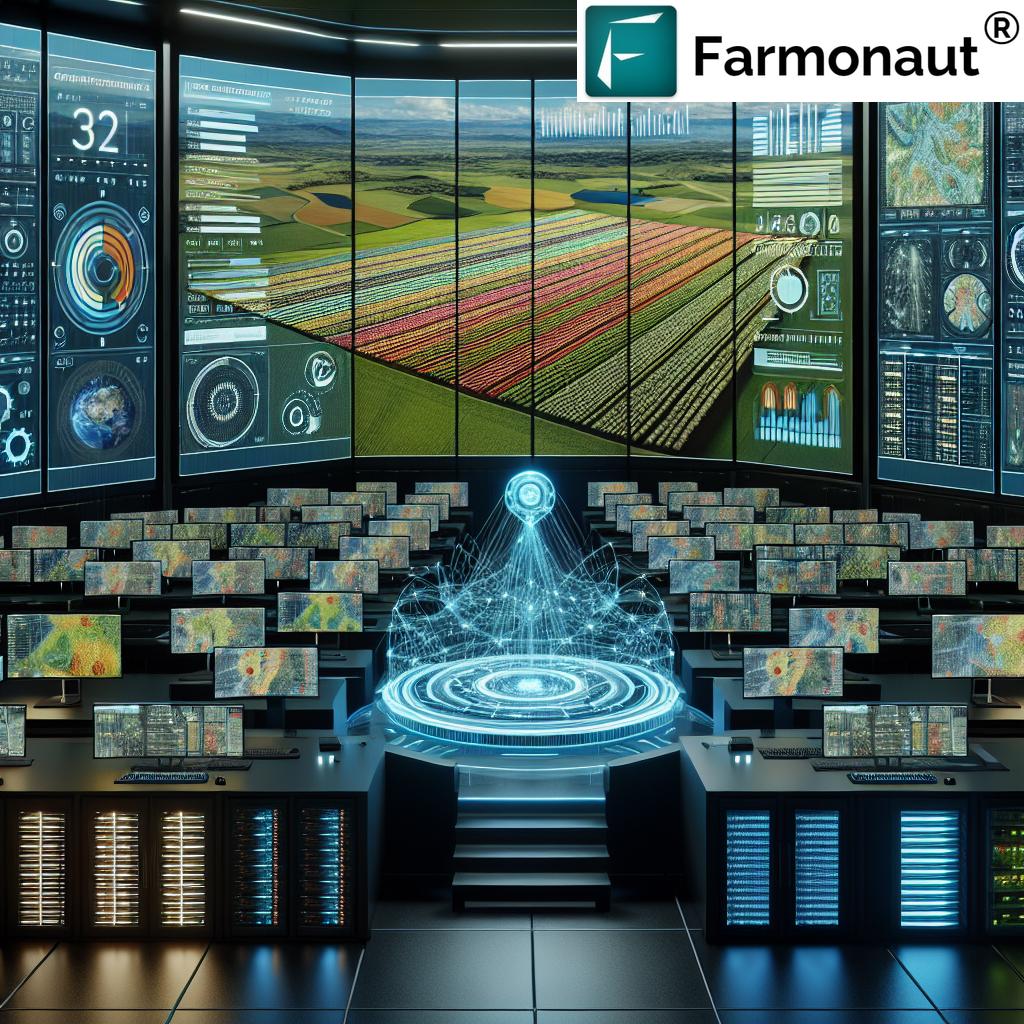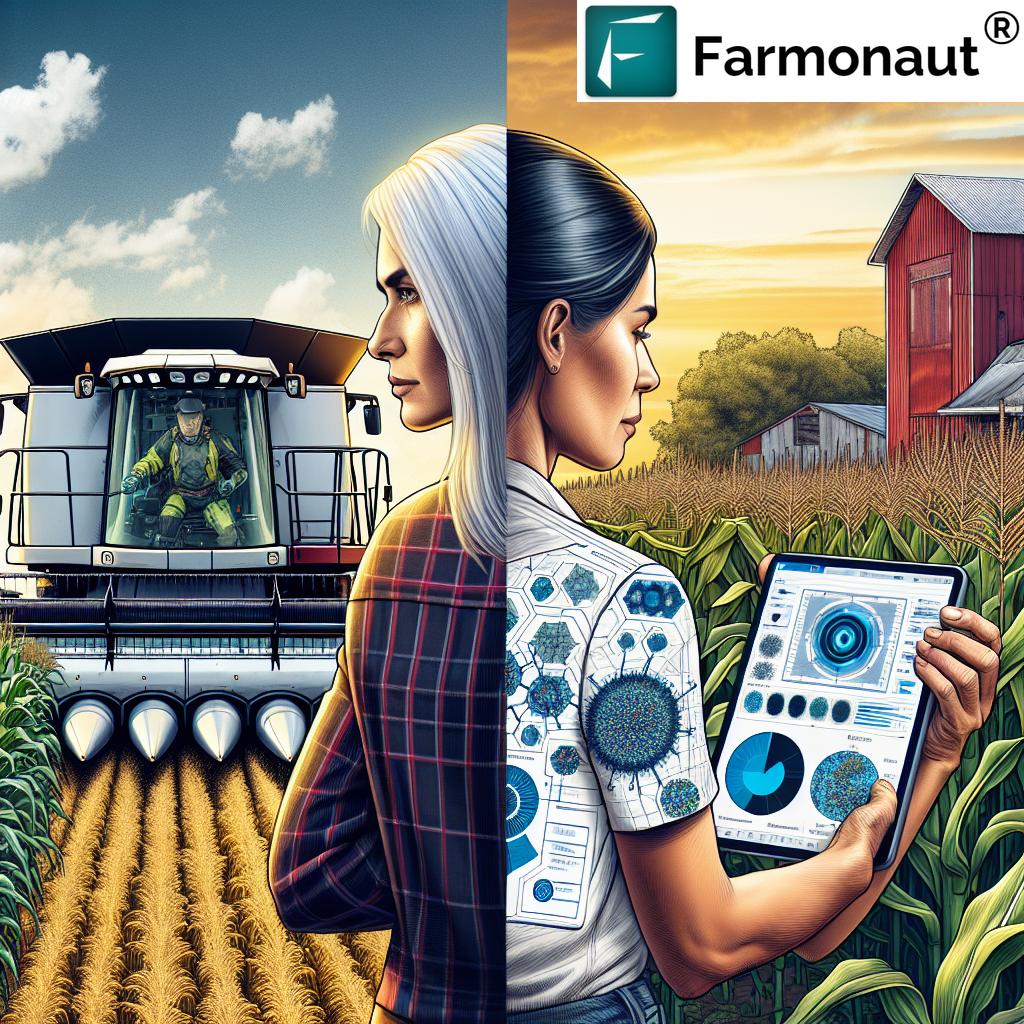Revolutionizing Agricultural Market Analysis: Farmonaut’s Precision Satellite Crop Monitoring for Informed Decision-Making
“Farmonaut’s blog covers over 10 agricultural topics, including crop monitoring, weather forecasts, and market analysis.”
Welcome to our comprehensive exploration of the latest advancements in agricultural market analysis and crop weather forecasts. At Farmonaut, we’re committed to bringing you cutting-edge insights into precision agriculture technology, empowering farmers and agribusinesses with the tools they need to make informed decisions. In this blog post, we’ll delve into the revolutionary world of satellite crop monitoring and its impact on modern farming practices.

The Evolution of Agricultural Market Analysis
In recent years, the agricultural sector has undergone a significant transformation, driven by technological advancements and the need for more sustainable farming practices. Traditional methods of market analysis and crop monitoring are being supplemented, and in some cases replaced, by sophisticated satellite-based solutions. This shift has opened up new possibilities for farmers, traders, and policymakers to gain real-time insights into crop health, weather patterns, and market trends.
At Farmonaut, we’re at the forefront of this revolution, offering state-of-the-art satellite crop monitoring services that provide unparalleled accuracy and timeliness in agricultural data collection and analysis. Our platform integrates seamlessly with various aspects of farm management, from daily weather reports to long-term crop yield forecasts.
The Power of Precision Satellite Crop Monitoring
Precision satellite crop monitoring is transforming the way we approach agricultural market analysis. By leveraging advanced satellite technology, we can now observe vast agricultural areas with incredible detail, providing valuable insights that were previously unattainable. Here’s how this technology is making a difference:
- Real-time Crop Health Assessment: Our satellite imagery allows for continuous monitoring of crop health, enabling early detection of issues such as pest infestations, disease outbreaks, or nutrient deficiencies.
- Accurate Yield Predictions: By analyzing historical data and current crop conditions, we can provide more accurate yield forecasts, helping to stabilize markets and inform pricing strategies.
- Efficient Resource Management: Farmers can optimize their use of water, fertilizers, and pesticides based on precise data about soil moisture levels and crop needs.
- Weather Impact Analysis: Our system integrates weather data with crop monitoring, allowing for better understanding of how climate conditions affect crop development and yields.
These capabilities not only enhance individual farm productivity but also contribute to more accurate and timely agricultural market reports and outlooks.
Integrating Market Reports with Satellite Data
One of the most significant advantages of our approach is the integration of traditional market reports with satellite-derived data. This combination provides a more comprehensive view of the agricultural landscape, enabling stakeholders to make better-informed decisions. Here’s how we’re bridging this gap:
- Enhanced Weekly Summaries: Our weekly market reports now include satellite imagery analysis, offering insights into crop progress across different regions.
- Dynamic Price Forecasting: By correlating crop health data with historical price trends, we can provide more accurate price forecasts for various commodities.
- Supply Chain Optimization: Satellite data helps in predicting harvest times and yields, allowing for better planning in the agricultural supply chain.
- Risk Assessment: Our integrated approach provides a clearer picture of potential risks, from weather-related threats to market volatility.
Try our web app to experience the power of integrated market analysis and satellite crop monitoring.

Weather Forecasts and Agricultural Decision-Making
Weather plays a crucial role in agricultural production, and our advanced forecasting capabilities are helping farmers make more informed decisions. Here’s how our weather-related services are making a difference:
- Precision Weather Forecasts: Our satellite-based weather forecasting provides highly localized predictions, crucial for day-to-day farm operations.
- Drought Monitoring: We offer comprehensive drought maps and alerts, helping farmers and policymakers respond proactively to water scarcity issues.
- Frost and Heat Wave Predictions: Our system provides early warnings for extreme weather events, allowing farmers to take preventive measures.
- Rainfall Analysis: Detailed precipitation maps help in planning irrigation schedules and assessing crop water needs.
These weather-related insights, combined with our crop monitoring data, provide a powerful tool for agricultural risk management and strategic planning.
“Satellite crop monitoring can provide daily updates on weather conditions and drought status for informed farm management.”
Livestock and Commodity Market Integration
While our primary focus is on crop monitoring, we understand the interconnected nature of agricultural markets. Our platform also provides valuable insights for the livestock sector:
- Pasture Health Monitoring: Satellite imagery helps assess the quality and quantity of available grazing land, crucial for livestock management.
- Feed Crop Analysis: Our crop monitoring extends to feed crops, providing livestock farmers with insights into potential feed availability and prices.
- Market Correlation Studies: We analyze how crop conditions and yields impact livestock markets, offering a more comprehensive view of agricultural economics.
By integrating these diverse aspects of agriculture, we provide a holistic view of the market, benefiting both crop and livestock producers.
The Role of AI and Machine Learning in Agricultural Analysis
At Farmonaut, we leverage advanced AI and machine learning algorithms to enhance our agricultural market analysis. These technologies allow us to:
- Process Vast Amounts of Data: Our AI systems can analyze terabytes of satellite imagery and weather data in real-time, providing rapid insights.
- Identify Patterns and Trends: Machine learning algorithms help in detecting subtle patterns in crop growth and market movements that might be missed by human analysts.
- Predictive Analytics: By analyzing historical data and current conditions, our AI can make more accurate predictions about future crop yields and market trends.
- Personalized Recommendations: Our system can provide tailored advice to farmers based on their specific crop types, location, and historical farm data.
These AI-driven insights are revolutionizing how we approach agricultural market analysis, making it more precise, timely, and actionable.
Explore our API for integrating our advanced analytics into your systems.
Sustainable Farming Practices and Market Dynamics
Sustainability is at the heart of modern agriculture, and our satellite monitoring technology plays a crucial role in promoting sustainable farming practices. Here’s how:
- Resource Optimization: By providing precise data on crop needs, we help farmers reduce overuse of water, fertilizers, and pesticides.
- Carbon Footprint Monitoring: Our technology can help track and quantify the carbon sequestration potential of different farming practices.
- Biodiversity Assessment: Satellite imagery can be used to monitor the impact of farming on local ecosystems and biodiversity.
- Sustainable Market Trends: We track and analyze market trends related to sustainably produced crops, helping farmers align with consumer preferences.
These sustainable practices not only benefit the environment but also often lead to cost savings and premium prices in the market.

The Future of Agricultural Market Analysis
As we look to the future, we see several exciting developments on the horizon for agricultural market analysis:
- Integration of IoT Devices: Combining satellite data with ground-based IoT sensors will provide even more accurate and localized insights.
- Blockchain for Traceability: Implementing blockchain technology to enhance the traceability of agricultural products from farm to consumer.
- Advanced Predictive Models: Developing more sophisticated predictive models that can account for complex factors like climate change and changing consumer preferences.
- Global Market Integration: Expanding our analysis to provide a more comprehensive view of global agricultural markets and trade flows.
These advancements will further enhance the accuracy and value of agricultural market analysis, benefiting farmers, traders, and consumers alike.
Empowering Farmers with Mobile Technology
To make our advanced agricultural market analysis and crop monitoring tools more accessible, we’ve developed user-friendly mobile applications. These apps bring the power of satellite technology directly into the hands of farmers:
- Real-time Alerts: Farmers receive instant notifications about critical changes in their crops or market conditions.
- Field Mapping: Easy-to-use interfaces for mapping and monitoring individual fields.
- Market Insights: Access to up-to-date market reports and price forecasts directly on mobile devices.
- Weather Updates: Localized weather forecasts and alerts tailored to specific farm locations.
Download our mobile apps to access these features on the go:


Agricultural Market Analysis Dashboard
To provide a comprehensive overview of current market conditions and crop health, we’ve developed an Agricultural Market Analysis Dashboard. This tool combines traditional market indicators with our satellite-derived data, offering a unique and valuable resource for decision-making in agriculture.
| Metric | Corn | Wheat | Soybeans |
|---|---|---|---|
| Current Market Price ($/bushel) | 5.75 | 6.20 | 13.85 |
| Price Change (%) | +2.3% | -1.5% | +0.8% |
| Crop Health Index (0-100) | 85 | 78 | 82 |
| Projected Yield (bushels/acre) | 180 | 55 | 50 |
| Weather Risk Factor | Low | Medium | Low |
| Satellite-Derived Biomass Estimate (tons/hectare) | 12.5 | 7.8 | 4.2 |
| NDVI Score | 0.75 | 0.68 | 0.72 |
| Soil Moisture Index (%) | 65% | 58% | 62% |
| Pest/Disease Risk | Low | Medium | Low |
| Market Sentiment | Bullish | Neutral | Bullish |
This dashboard provides a quick, data-rich overview of current market conditions, crop health, and future projections. It combines traditional market analysis with Farmonaut’s precision satellite monitoring capabilities, offering readers a comprehensive tool for informed decision-making in agriculture.
Leveraging Data for Agricultural Policy and Trade
The insights provided by our satellite crop monitoring and market analysis tools extend beyond individual farm management. They also play a crucial role in shaping agricultural policy and international trade:
- Policy Formulation: Governments can use our data to develop more informed agricultural policies, subsidy programs, and food security strategies.
- Trade Negotiations: Accurate crop production forecasts can inform international trade negotiations and help in managing agricultural commodity flows.
- Food Security Planning: Our global crop monitoring capabilities assist in early warning systems for potential food shortages or surpluses.
- Environmental Compliance: Satellite data can help in monitoring compliance with environmental regulations in agriculture.
By providing reliable, up-to-date information on global crop conditions and market trends, we contribute to more stable and efficient agricultural markets worldwide.
The Impact of Climate Change on Agricultural Markets
Climate change is one of the most significant challenges facing agriculture today. Our satellite monitoring technology is playing a crucial role in understanding and adapting to these changes:
- Long-term Trend Analysis: By analyzing historical satellite data, we can identify long-term changes in crop patterns and productivity due to climate change.
- Adaptation Strategies: Our insights help farmers and policymakers develop strategies to adapt to changing climate conditions, such as shifting planting dates or introducing new crop varieties.
- Risk Assessment: We provide data-driven assessments of climate-related risks to agricultural production, helping in the development of resilience strategies.
- Carbon Sequestration Monitoring: Our technology can track the effectiveness of various agricultural practices in sequestering carbon, contributing to climate change mitigation efforts.
By integrating climate data with our crop monitoring and market analysis, we provide a more comprehensive view of the challenges and opportunities in modern agriculture.
Empowering Smallholder Farmers
While our technology offers significant benefits to large-scale agricultural operations, we’re equally committed to empowering smallholder farmers. Here’s how our solutions are making a difference for smaller farms:
- Affordable Access: We offer scaled-down versions of our tools at affordable prices, making precision agriculture accessible to smaller operations.
- Community-based Insights: By aggregating data from multiple small farms in a region, we provide valuable collective insights that benefit entire farming communities.
- Education and Training: We offer resources and training to help smallholder farmers interpret and apply the insights from our satellite monitoring and market analysis tools.
- Connecting to Markets: Our market analysis helps smallholder farmers make informed decisions about what to grow and when to sell, improving their market access and profitability.
By democratizing access to advanced agricultural technology, we’re helping to level the playing field and improve food security at a grassroots level.
The Role of Farmonaut in Agricultural Innovation
At Farmonaut, we’re not just providing tools; we’re driving innovation in the agricultural sector. Our commitment to research and development ensures that we’re always at the forefront of agricultural technology:
- Continuous Improvement: We’re constantly refining our algorithms and models to provide even more accurate and timely insights.
- Collaboration with Research Institutions: We work closely with agricultural research institutions to validate and improve our methodologies.
- User-Driven Innovation: Feedback from our users drives much of our innovation, ensuring that our tools meet real-world needs.
- Exploring New Technologies: We’re always exploring new technologies, such as hyperspectral imaging and AI-driven predictive models, to enhance our offerings.
Our goal is to continue pushing the boundaries of what’s possible in agricultural market analysis and crop monitoring, providing ever more valuable tools to the farming community.
Farmonaut Subscriptions
To access our full range of advanced agricultural market analysis and satellite crop monitoring tools, consider subscribing to Farmonaut. Our subscription plans are designed to meet the diverse needs of farmers, agribusinesses, and agricultural professionals.
Frequently Asked Questions (FAQ)
Q: How accurate is satellite-based crop monitoring?
A: Our satellite-based crop monitoring is highly accurate, with precision levels often exceeding 90%. However, accuracy can vary depending on factors such as cloud cover and crop type.
Q: Can Farmonaut’s tools be used for all types of crops?
A: Yes, our tools are designed to work with a wide range of crops. While some crops may be easier to monitor than others, we continuously update our algorithms to improve detection and analysis for various crop types.
Q: How often is the satellite data updated?
A: The frequency of updates depends on the subscription plan and the specific location. Generally, we provide updates every 3-5 days, with some premium plans offering daily updates for certain regions.
Q: Is Farmonaut’s technology suitable for small farms?
A: Absolutely! We offer scaled solutions that are suitable and affordable for farms of all sizes, including small family-owned operations.
Q: How does Farmonaut integrate weather data into its analysis?
A: We combine data from multiple weather satellites and ground stations with our crop monitoring data to provide comprehensive weather insights and forecasts tailored to specific agricultural needs.
Conclusion: The Future of Agriculture is Here
As we’ve explored in this comprehensive overview, the integration of satellite crop monitoring with traditional agricultural market analysis is revolutionizing the farming industry. At Farmonaut, we’re proud to be at the forefront of this transformation, providing farmers, agribusinesses, and policymakers with the tools they need to make informed decisions in an increasingly complex agricultural landscape.
From real-time crop health monitoring to advanced weather forecasting, from market trend analysis to sustainable farming practices, our technology is helping to create a more efficient, productive, and sustainable agricultural sector. As we look to the future, we’re excited about the possibilities that continued technological advancements will bring to the field of agriculture.
We invite you to join us on this journey of agricultural innovation. Whether you’re a small family farmer or a large agribusiness, our tools and insights can help you optimize your operations, reduce risks, and increase profitability. Together, we can build a more sustainable and food-secure future for all.
Ready to revolutionize your approach to agriculture? Try Farmonaut today and experience the power of precision satellite crop monitoring for yourself!
For developers interested in integrating our powerful agricultural data into their own applications, we encourage you to explore our API and API Developer Docs. Let’s work together to drive innovation in agriculture!

















